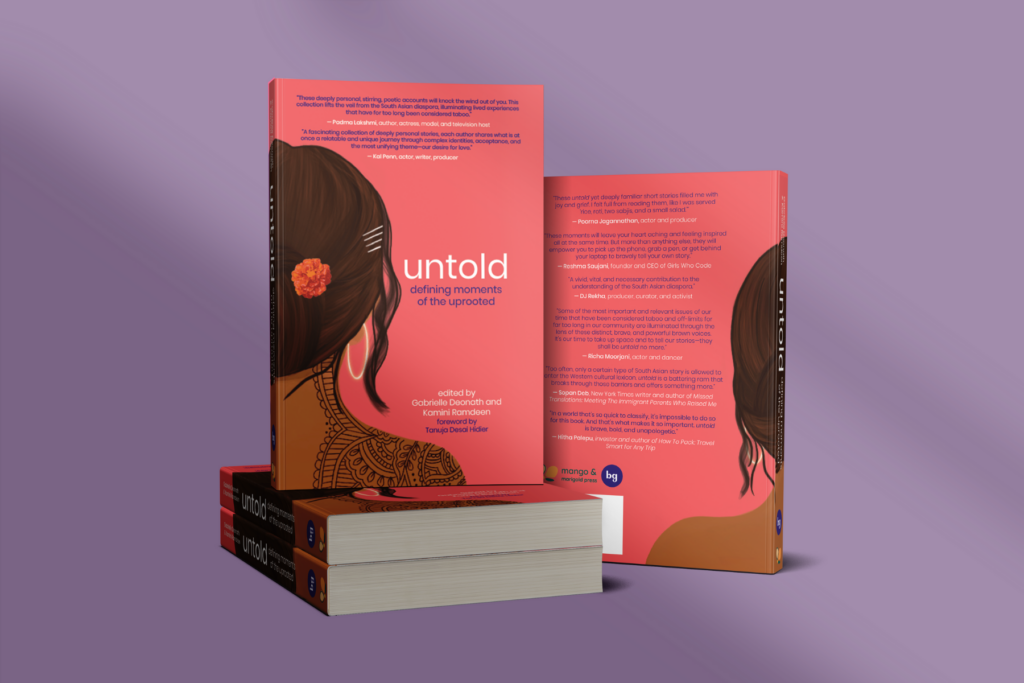
The team at Brown Girl Magazine released our first-ever print anthology—“untold: defining moments of the uprooted,” edited by Gabrielle Deonath and Kamini Ramdeen—in partnership with award-winning independent publishing house Mango and Marigold Press earlier this year.
Written by an intergenerational group of South Asian contemporary storytellers from the U.S., U.K., Canada, and Denmark, the stories in “untold” explore a defining personal moment in each of the writers’ lives through a creative nonfiction lens. In three sections, each author brings an uprooted view to the themes of identity, being, and relationships.
Identity explores the ways in which others perceive us and how we define ourselves. These narratives of self-discovery and reflection take us down the winding roads of immigration, racism, coming out, caste, faith, living in a post-9/11 world and conformity or lack thereof.
In Being, we probe the many parts of our existence—from the body to mind to soul. In this examination of South Asian women’s journeys, we expose the harsh truths of colorism, women’s health, mental health, suicide, addiction, infertility, and connection to the body.
Relationships highlights the essential bonds that shape us, mold us, bring joy, and wreak havoc in our lives. These moments give a glimpse into the sometimes precarious roles that women play as lovers, wives, mothers, sisters, daughters, daughters-in-law, and best friends.
View this post on Instagram
This powerful collection of South Asian diasporic narratives would not be possible without the 32 brave souls who trusted us to help them share their once silenced, hidden, untold stories with the world. Here is a sneak-peek into the moments that make up “untold” and the writers to whom they belong.
Ravleen K.
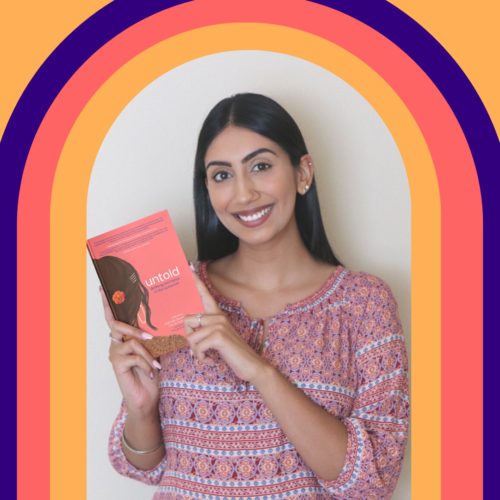
About the story: My story is about the life-changing decision I made to fit in with my homogenous Southern community—which ended up backfiring. This is a decision I regret to this day, and the outcome has fueled my belief in building diverse and accepting communities. No child should ever feel ostracized or left behind for the way they look.
About the author: Ravleen is a marketer and writer based in Austin, Texas. Having lived her life between five cities in various regions of the country, she uses her diverse experiences to advocate for mental health awareness with MannMukti and write thoughtful pieces on religion and culture for Brown Girl Magazine. Drawing on her love for Punjabi music, she also serves as an editor for brwncltr.com.
Sabina England
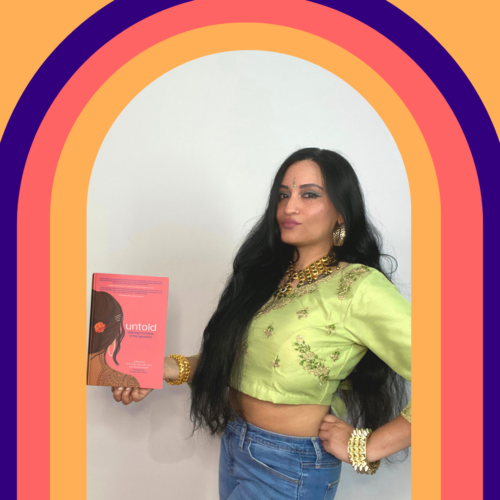
About the story: Growing up as a fully deaf, brown, immigrant, Muslim girl, I felt very different from everyone else. I had no connection to most people around me until I met and fell in love with an incredible man, who was indigenous and undocumented. He showed me the beauty of the world, and he made me feel loved and accepted. Then our story took an unexpected turn that tested my faith and forced me to face grief unlike ever before.
About the author: Sabina England is an award-winning filmmaker and playwright whose works have been shown in London, New York City, Los Angeles, Paris, and other cities around the world. She recently wrote, produced, and performed a solo show called “Allah Earth: The Cycle of Life” at the New York International Fringe Festival. She also won a Jury Award in Los Angeles for her short film, “Deaf Brown Gurl.”
Chandra Coats
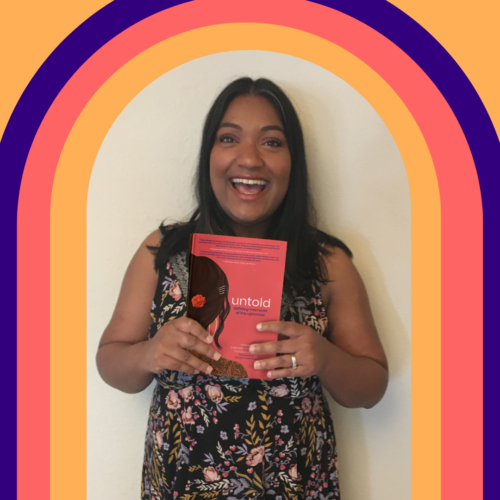
About the story: I am a transracial adoptee. I have never met my biological mother and know very little about her. During my pregnancy and the birth of my child, I couldn’t help but wonder about her and reflect on the relationship we were never able to have. These moments make up my story in “untold.”
About the author: Chandra Coats is a transracial adoptee, originally from Kolkata, West Bengal, and raised in Southern California. She is now a stay-at-home parent but has worked in advocacy for children, sexual assault survivors, and immigrants. She is married to her husband Dan, a friend since childhood. She is of a confessional Reformed Christian faith and is a political independent.
Rita Sengupta
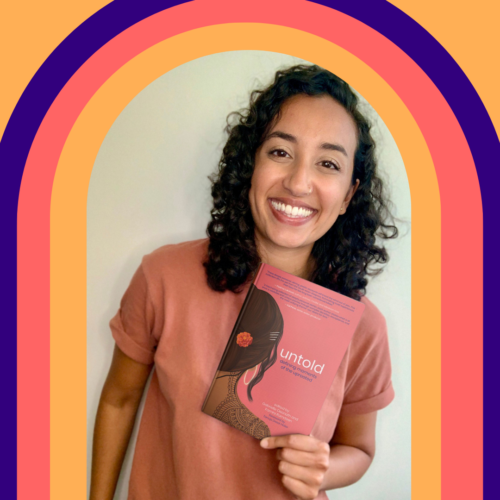
About the story: This is a story about the continual process of establishing my queerness to my devout Christian mother.
About the author: Rita Sengupta is a queer South Asian-American actor and comedian based in Brooklyn, New York. Her work has been featured by WNYC, Buzzfeed, and Glamour Magazine. She previously performed at NYC Sketchfest and the Asian Comedy Festival. You can find her around NYC doing stand-up and performing with various sketch comedy groups. Rita studied at Atlantic Theater Acting School and Upright Citizens Brigade. She graduated from Washington University in St. Louis with a BSBA in finance and marketing.
L.M. Iyer
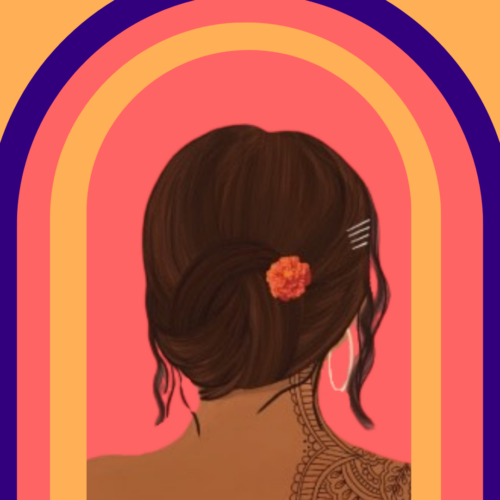
About the story: My story is about the moment as a performance artist when I realized that much of my identity—straddling the color line between being ethnically Indian and culturally American—had been made into a performance for audience approval.
About the author: L.M. Iyer (pen name) is a graduate student studying creative writing. She grew up in a small coastal town but currently resides in the American South. Her work revolves around themes of perception, identity and transition.
Meera Solanki Estrada
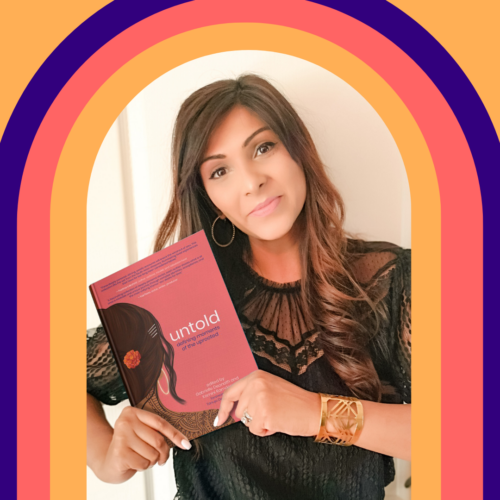
About the story: My story explores how being born Untouchable shaped my identity and how casteism continues to persist, even in the diaspora.
About the author: Meera Solanki Estrada is the host and producer of “kultur’D,” a pop culture radio show on Global News Radio in Canada. She is also the founder of FUSIA Media, a premier online destination and experiential hub for the modern Canadian South Asian Woman. It is where fashion, lifestyle and entertainment intersect with global citizenship. A wife, mother and media maven, Meera wants to inspire women to live their best life in the pursuit of their passions and goals. She has bylines in ELLE Canada, Shondaland, Bustle, The Huffington Post, CBC Life, FLARE and Chatelaine, to name a few. She also appears regularly on local and national television and radio broadcasts as a beauty and culture expert. With a degree from the Schulich School of Business paired with a post-graduate in radio and television broadcast journalism, Meera’s education and experience are a force of media savvy. She embodies her brand mantra of fashion meets compassion meets South Asian style.
Hena Wadhwa
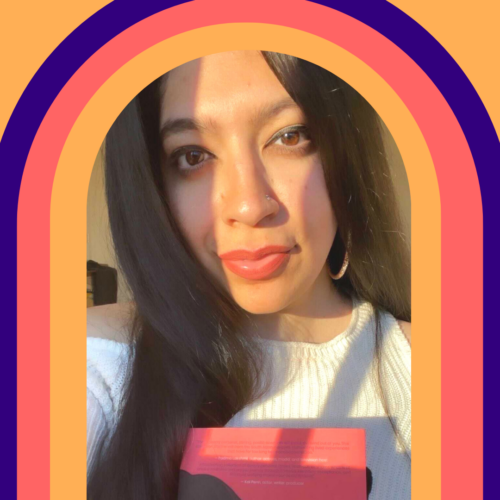
About the story: My story centers around the moment that I first witnessed domestic violence at a time when I was also starting to recognize the South Asian gender biases surrounding me. This was the breaking moment that led me to a path of advocacy for survivors, victims and all women.
About the author: Hena Wadhwa is a women’s activist and former educator, who earned her doctorate at Florida State University. Her research interests range across women’s health, motherhood, mental health and maternal and child health. Hena pursued a career as a special education teacher and taught in neighborhoods that were underserved and lacked appropriate resources for students with disabilities. After serving a few years in education, Hena discovered that across educational realms, there was a particular emphasis on mothers, their roles and expectations. She is determined to utilize her research and leadership to bring forward the voices and experiences of all women and, in particular, highlight the experiences of South Asian American women. She is excited to pursue a career that embodies research, advocacy, and leadership. Hena is the first woman in her family to earn a PhD and is dedicated to her mission of women’s rights and equality. Besides striving to do right by women, she also loves kickboxing, weight lifting, herbal teas and watching reruns of “The Golden Girls” (her spirit animal is Sophia and Dorothy—confirmed by a BuzzFeed quiz).
Nova A.
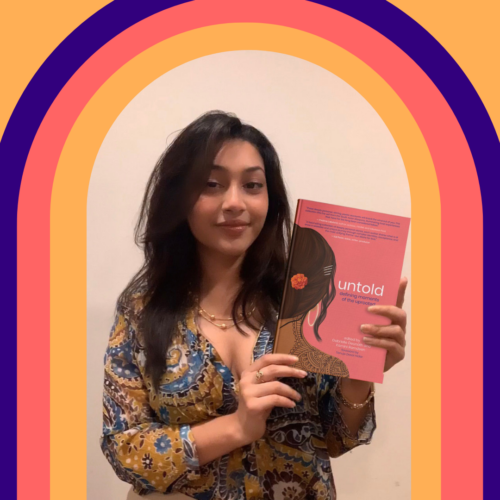
About the story: My story is about the day I came out to my father and includes flashbacks to impactful moments in my relationship with my sexuality, particularly the moments that made me question whether I was bisexual.
About the author: Nova A. is a Bangladeshi-American model, actress, creative, activist and Knick‘s Poetry Scholarship recipient. They often use their platform to discuss LGBTQ issues and diverse representation in media, as well as speak out against rape culture. Nova made their acting debut in an off-Broadway documentary theatre piece called “Sharum.” You may recognize them from several music videos for artists like Yung Baby Tate and Ali Gatie and in campaigns for brands like WeSoForeign by Anik Khan.
J. Lalwani

About the story: My story is about my journey of embracing my roots. Through the pain of racism, I was forced to face my Indianness and eventually find freedom in accepting my identity.
About the author: J. Lalwani is a first-generation Indian American. She works as a stockbroker and recently earned her master’s degree from Harvard University. She has interests in women’s empowerment, racial inequity and self-discovery. She is an avid runner and loves a good joke.
Amrisa Niranjan

About the story: My story shares my perspective as a four-year-old on the curious experience of becoming an immigrant.
About the author: Amrisa Niranjan is a Guyanese-born artist and muralist, who creates work to engage audiences in dialogue about the nuanced contemporary immigrant and minority experience. The focus of her work is to further expand the narrative of the world’s colonized diaspora by identifying often-overlooked collective elements that stitch descendants of once-colonized or enslaved people to one another. Niranjan highlights the enigmatic beauty of these cultures, which evolved to transcend histories of trauma to create multitudes of new expression in music, art, dance and language that continue to impact the world today.
Radhika Patel
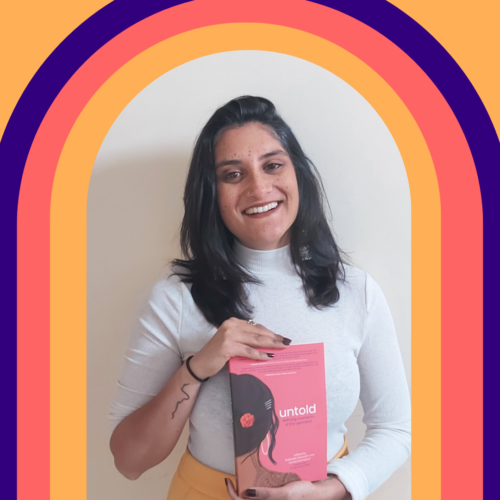
About the story: My story explores the trauma of a colonial legacy that unsuspectingly creeps into the walls and bodies we call home.
About the author: Radhika Patel, from Leicester, U.K., now resides in London, where she works for a social justice campaigns organization. She believes the world would be a better place if everyone engaged with their power and privilege more, got messy eating mangoes over the sink more, and shared food with loved ones more.
Shimul Chowdhury
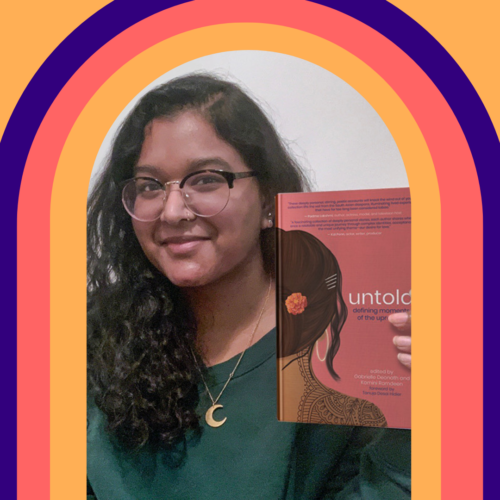
About the story: In the wake of 9/11, I experienced a ‘well-intentioned’ microaggression that continues to make me question my sense of belonging in the United States 20 years later.
About the author: Shimul Chowdhury is a Muslim Bangladeshi-American artist currently residing in Central Florida. She received a BFA in Art and Technology from the University of Florida and an MFA in Digital Arts and New Media from the University of California, Santa Cruz. She has recently focused her work on recording and sharing the lived experiences of Muslims in the U.S. through textile craft, dialogue and participation. Outside of her art practice, she is also passionate about teaching, playing video games and knitting.
Gabrielle Deonath
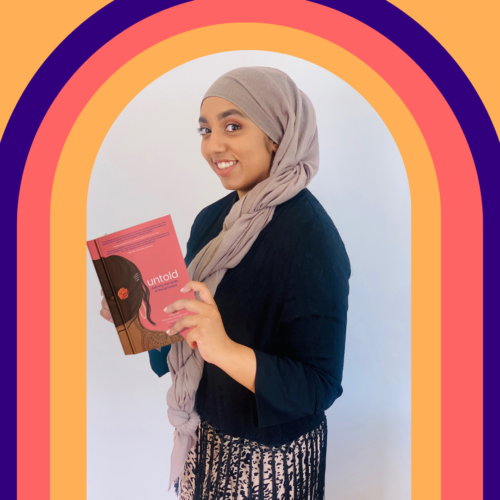
About the story: I stitched together important moments from the 8-month journey that culminated in my decision to wear the hijab at the age of 16—a decision that changed my life in so many ways.
About the author: Gabrielle Deonath is a Guyanese-American writer, editor, and content creator based in New York. She hopes to give voice to those without a platform and promote authentic representations of minorities and marginalized communities through storytelling. Her writing has appeared in publications including SISTERS Magazine, the Muslim Creative Writers Network anthology Survival of the Hardworking, VirtualMosque.com, and Brown Girl Magazine, where she has also served as an assistant editor for the Indo-Caribbean and political teams. She is also one of the editors of “untold.” Read more of her work at www.hijabdiaries.com.
Raksha Muthukumar
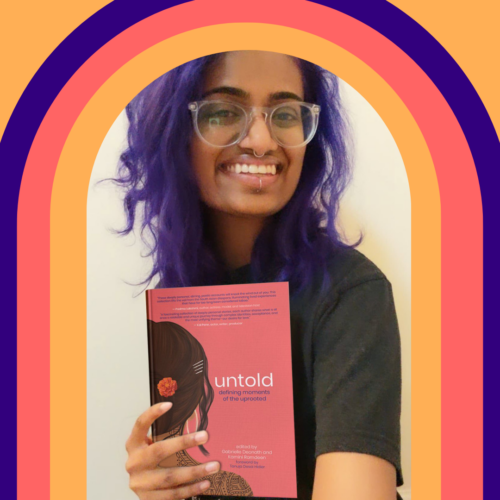
About the story: I tell the story of Fall 2017 when queer students were protesting against the administration of Georgia Tech University in a call for justice, culminating in the suicide of my best friend. This piece is in memory of the trans students who held the line and led us through an unimaginable time, and in honor of the Kirby I knew, who loved puzzles and held my hand when I was at my lowest.
About the author: Raksha Muthukumar is a Southerner-turned-New Yorker with a deep love for brunch, beer and books. She is a podcaster and writer, who believes in storytelling as a means of empowerment for the marginalized. Raksha is passionate about the radical liberation of all people, and she is actively engaged in queer activism and work at the intersection of social justice and technology. By day, she is a software engineer at Google.
M.K. Ansari
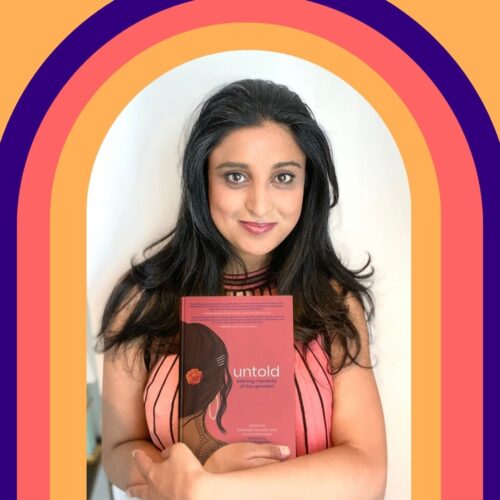
About the story: This is the story of my lifelong struggle with the voices that whisper to me, metaphorically and literally.
About the author: M.K. Ansari is a Canadian-born Silicon Valley Fortune 500 corporate lawyer, television writer and mom. She has written for prominent outlets including Reuters, CNN, and Huffington Post and is a former editor of Illume Magazine. She currently works as a lawyer and is writing for two pre-production stage streaming programs, while completing the Professional Program in TV Writing at UCLA. She is the co-founder of the Muslim Women’s Art Society and co-host of “The Good Girl Playbook Podcast” about brown women who defy cultural norms.
Pooja Patel
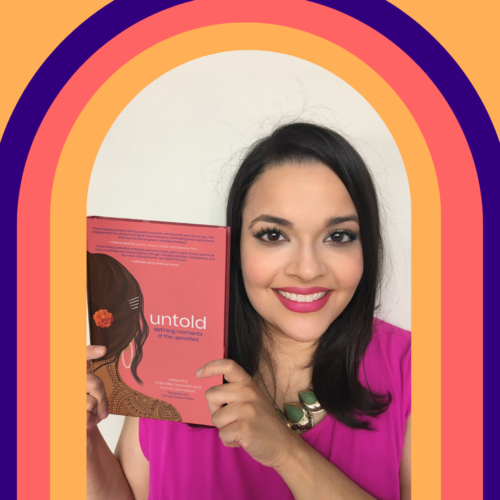
About the story: I share moments from my journey with infertility and infant loss—a struggle that is so common amongst South Asians but rarely spoken about—that led my husband and me to surrogacy.
About the author: Pooja Patel is a former economic developer from Atlanta, Georgia, who is married to her high school sweetheart. After years of infertility, miscarriage and infant loss, she shares her story so others know they are not alone in their struggles. Pooja’s passions include community development and women’s reproductive rights.
Apoorva Verghese
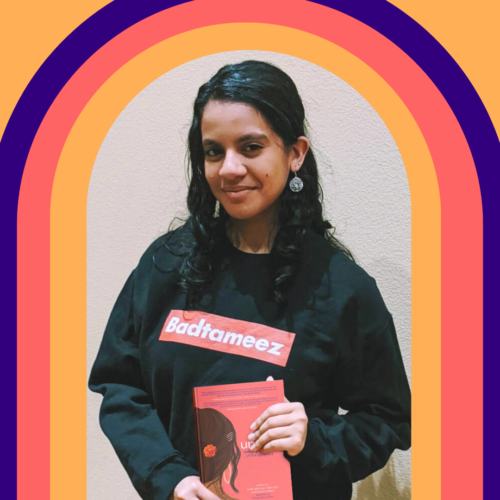
About the story: My story is about my childhood experience with colorism—both internalized and fed by others—and the damaging decision to which it led me.
About the author: Apoorva Verghese was born in England and raised in America. She considers herself a modern-day nomad. As a student at Tulane University, she hopes to further her knowledge on culture, identity and their effects on this world. In the future, she hopes to pursue a career in civil rights law.
Subrina Singh
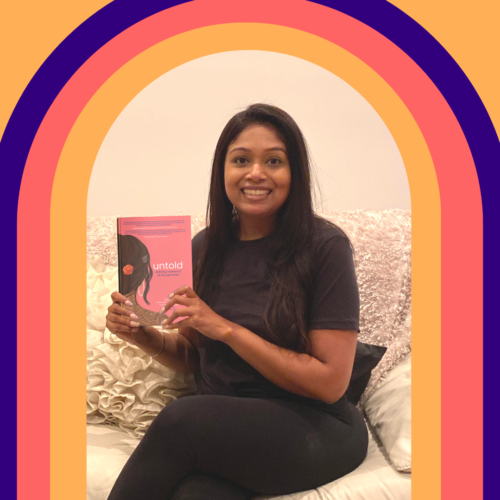
About the story: My story is of a young woman navigating loss and grief, while also battling a mental illness.
About the author: Subrina Singh holds a bachelor’s degree in Asian and Asian American studies from Stony Brook University and a master’s degree in South Asian religion and philosophy from Columbia University. She is a contributing author in the anthology of Sikh love stories, “Her Name is Kaur.” Since its release, she has become committed to using her experience with mental illness to help improve the awareness of mental health within the South Asian community. Subrina was a featured guest on TV Asia’s “Shades of Shakti” and has collaborated with organizations such as SAMHAJ NAMI and the NYC Department of Mental Health and Hygiene. She is proud of her journey and determined to use her own experience with bipolar disorder to help others suffering from mental illness.
Nupur Chaudhury

About the story: I share the tumultuous relationship that I have had with my body throughout my life and the journey of getting to know and becoming friends with my body that resulted.
About the author: Nupur Chaudhury is an urbanist, strategist, ceramicist and dreamer based in New York City. She loves gardening, exploring cities and getting to know dogs of all shapes and sizes.
Jessie Brar
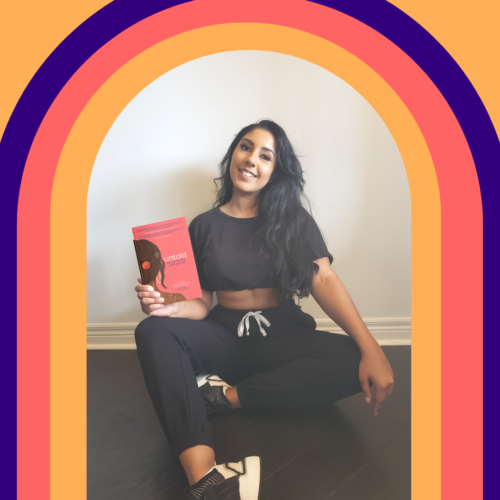
About the story: This is the untold story of a woman at the moment she realized it was time to ask for help in her battle with mental health and addiction.
About the author: Jessie Brar is a public speaker, writer and mental health activist from Toronto. Growing up, she struggled a lot with her own mental health, and in an attempt to understand herself more, she went on to study Psychology at Queen’s University. After graduation, Jessie found there was no space for South Asians to have safe mental health conversations and started The Mental Health Spotlight. Jessie was recognized as one of the top 100 most influential Sikhs under 30 in 2020 for her work in this space. She continues to further these conversations through her podcast “Presents of Mind” and by sharing her story at events around the world.
Priyal Sakhuja
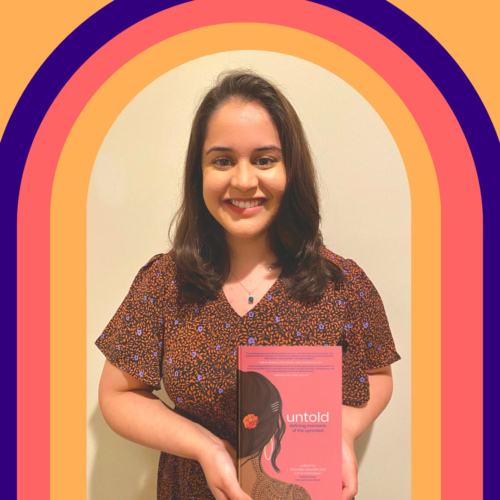
About the story: My story chronicles my battle with my appearance, my body and a host of symptoms that shook my confidence until I finally reached a diagnosis that helped me learn how to love and appreciate myself.
About the author: Priyal Sakhuja is currently a fourth-year medical student, who is passionate about preventative medicine and women’s health. She hopes to use her medical career to work with underserved communities. In her free time, Priyal loves to spend time with her family and friends, binge-watch Netflix, read and travel.
Anantha Sudhakar & Kimberly Parekh

About their story: Our story is about our journey as best friends living and supporting one another through our lives’ most profound challenge.
About the authors: Anantha Sudhakar is an associate professor of Asian American studies at San Francisco State University, where she teaches courses on Asian American literature and South Asian American history and culture. Her writing has appeared in The Scholar and Feminist Online, The Journal of Cancer Education, Small Axe, and The Asian Pacific American Journal, among other publications. Prior to her teaching career, Sudhakar spent a decade as an arts organizer in New York City. She currently serves as an academic advisor for the South Asian American Digital Archive, the largest historical repository about South Asian American immigration.
Kimberly Parekh is currently a Senior Education Advisor at UNICEF where she advises governments and civil society on strengthening education systems. She began her career by starting and managing community-based schools for thousands of marginalized and underserved children in India and later in Afghanistan. She later when on to work for various donors such as the U.S. government, World Bank, Global Partnership for Education, and Education Cannot Wait, among others. Her passion for education has led to teaching as an adjunct professor at the university level and mentoring young professionals. She has authored and contributed to numerous education publications and reports. Aside from work, Kimberly is an advocate of integrative and holistic medicine, has spoken at multiple conferences and written about its benefit for various regional and national organizations. She currently sits on the board of the Smith Center, where she advocates for national policies that support a whole-person approach towards treatment and well-being.
Rajvir Gill
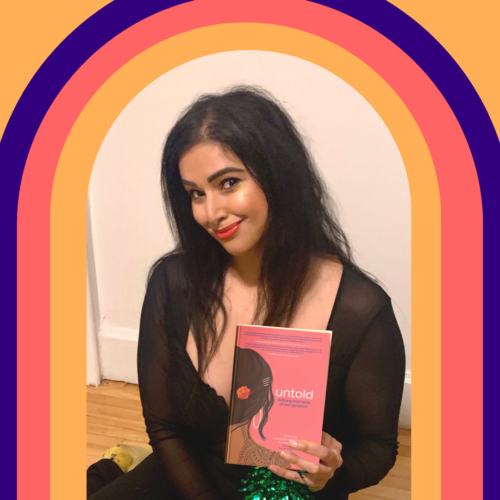
About the story: A woman decides whether to remain in her marriage after finding out her husband was unfaithful to her while she was struggling with depression.
About the author: Rajvir Gill is a lawyer currently working in the area of children’s rights. Before law school, Rajvir completed her bachelor’s of commerce (because her dad said it was the practical thing to do) and earned a master’s in political science (because she wanted to). She worked in the not-for-profit sector in her hometown of Edmonton, Canada, where she led projects against gender-based violence and human trafficking. Outside of her work and being in school for a very long time, Rajvir interned and studied in many places around the world, igniting not only her passion for travel but also her desire to work in human rights and international law. Books and stories have always been a constant companion for her, giving her access to other worlds. Rajvir’s contribution to this project is the realization of a life-long dream to write and share the difficulties of her life in order to connect and provide solace to others who may need it.
Nisha Singh
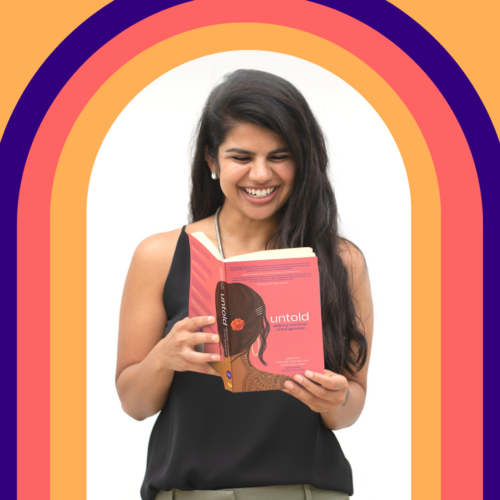
About the story: This is my story about navigating grief, a multi-hyphenated identity, and patriarchal norms after the death of my father.
About the author: Nisha Singh is an NGO professional in Washington, D.C. with a focus on women’s rights and empowerment and citizen engagement. She is currently pursuing a part-time master’s degree in public policy at Georgetown University. Her hobbies and social media content include pursuits of structured fun, such as book clubbing, volunteering with Sister District DC and teaching a weekly Doonya: The Bollywood Workout class.
saahil m.
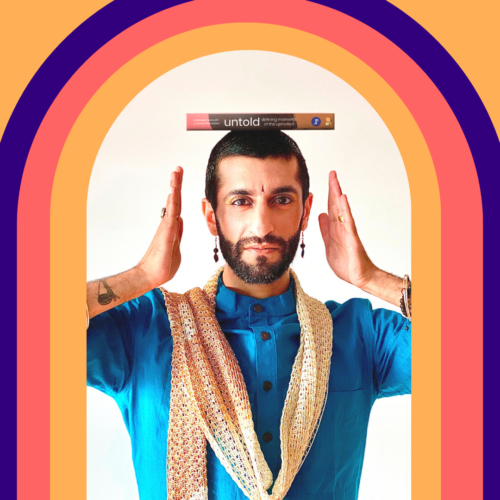
About the story: I narrate my parents’ long-awaited separation that I saw slowly coming to fruition since my birth and the ways in which their split particularly affected my mother.
About the author: Saahil sees themself as a writer and intercultural educator who has learned the importance of storytelling first as a student in the classroom and later as an educator. They speak Spanish and Portuguese and hope to learn Hindi and Arabic. They are currently pursuing a graduate degree in anthropology and education at Teachers College in New York City. They tend to write about love, lust, and longing—particularly where these notions intersect with the fine lines between optimism and pessimism, joy and melancholy, innocence, and insight. Saahil hopes their work diversifies existing literature and elevates historically oppressed voices as they continue to publish more in the (near) future.
Duriba Khan

About the story: This story contrasts my dad’s immigration journey to the U.S. from a small village in Pakistan with my visit to Pakistan as a teenager, born and raised in America.
About the author: Duriba Khan is a Texas-based writer and student, with work published across a spectrum of digital media outlets. Her interests include improv, filmmaking, reading, pursuing the most cinnamon-y chai latte in the greater Austin area and studying the law.
Nina Malagi
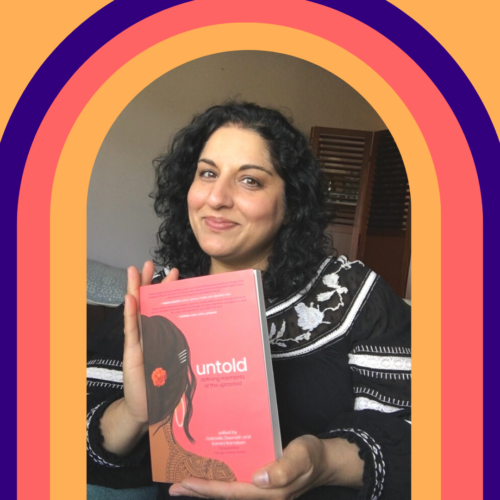
About the story: My story is about the courage required to own oneself entirely and break free from a familial male agenda that seeks to control and navigate one’s reality.
About the author: Nina Malagi was born and raised in London, but works and raises her tribe in New Jersey. She graduated from The University of Sussex in the U.K. from the School of African Asian Studies and earned a master’s in English literature. She was one of the first people to outsource herself to teach at an Indian university but happily abandoned her Ph.D. studies in comparing Kalidas to Shakespeare to join an experimental school focused on interactive and collaborative learning sponsored by the IBO. She was an editor for an English textbook that was used by millions of children in India to teach English with a decolonized pedagogy. She has taught in Paris, London and New Jersey. She is actively involved in her community, engaged in social justice and volunteers to help train teens to record and publish oral histories of their own immigrant community experiences.
Anita Wadhwani
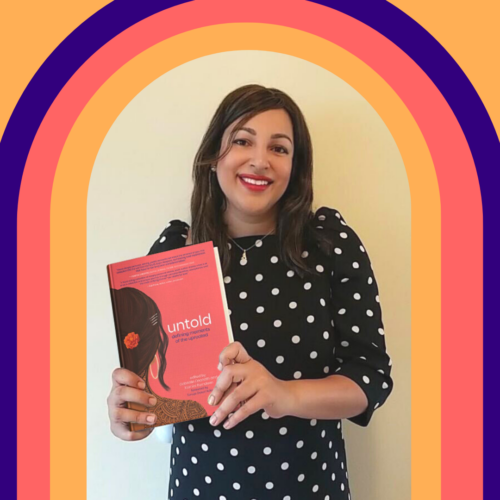
About the story: This is the story about how my life as a single woman in D.C. was upended as I took on caring for my mother, who lives with dementia after my father passed away.
About the author: Anita Wadhwani received her master’s in public and international affairs from the University of Pittsburgh and her bachelor’s in j0urnalism and mass communications from Point Park College. During her graduate studies, she was an intern at the Department of State and has made a career working in policy and government in Washington, D.C. Outside of her career, Anita has advocated for mental health awareness and elderly care in the South Asian American community, due to experiences within her own family. She was named a 40 Under 40 honoree for leadership in 2018 for Northern Virginia.
Radhika Menon
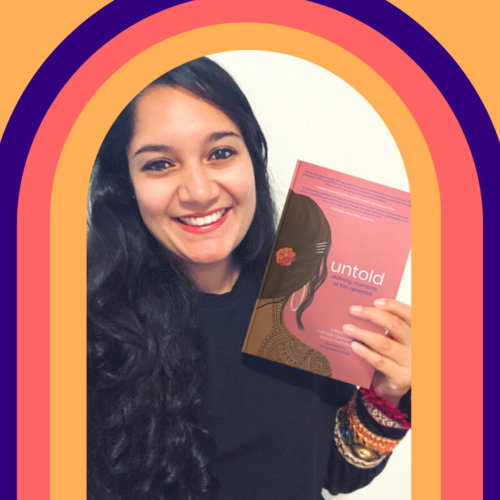
About the story: This is the story of the email I delayed sending to my grandfather until he passed away and understanding the struggles of my immigrant parents in the wake of his death.
About the author: Radhika Menon is a pop culture-obsessed writer, whose work has appeared in Teen Vogue, Decider, Paste Magazine, and Brown Girl Magazine. She is a proud alumna of the University of Michigan, one-half of the comedic video duo PromRad and is a self-professed pizza enthusiast. She resides in New York City.
Neha Patel
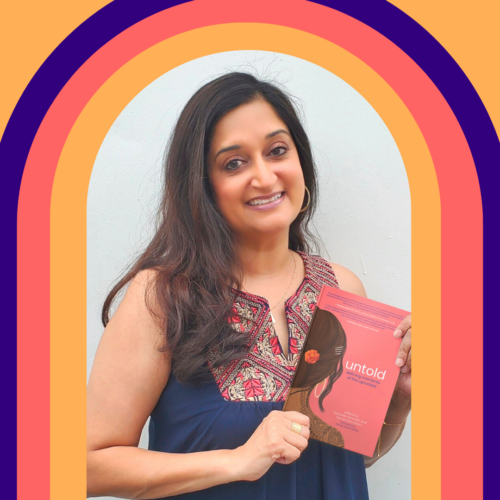
About the story: My story is about standing up for myself after years of losing myself within my relationship with my mother-in-law.
About the author: Neha Patel is a fiction and creative non-fiction writer. Born and raised in Ohio, she currently resides in Texas. She graduated with a degree in pharmacy from The Ohio State University in 1999. She is an advocate and a 2019 graduate of the Texas Partners in Policy Making program. Her short story in this anthology is her first publication.
—
For generations, we hid behind the societal expectations and obligations of those before us. Too scared to speak our truth, too afraid to be seen for who we are, or too proud to admit our wrongs. Our hope is for “untold” to serve as a space to do the opposite, to lift the veil on topics that are rarely spoken about openly in the larger South Asian community, to spark open-minded and open-hearted conversations about the experiences we only share in hushed tones. For us, “untold” is a hopeful start to the telling of all of the untolds we hold within but desperately want to let out.
A special thanks to journalist and creative director Aishwarya Sukesh for creating our anthology’s cover, artist Simran Sarin for the sub-theme artwork, Mitali Desai for the copy edits, author of “Born Confused” and “Bombay Blues” Tanuja Desai-Hidier for graciously writing our foreword, and Brown Girl’s CEO Trisha Sakhuja-Walia for overseeing the book’s development and marketing.
To support “untold,” order a copy from our shop, Amazon, or Barnes and Noble. To find out more about the anthology and the writers, follow @untold__browngirlmag on Instagram.




